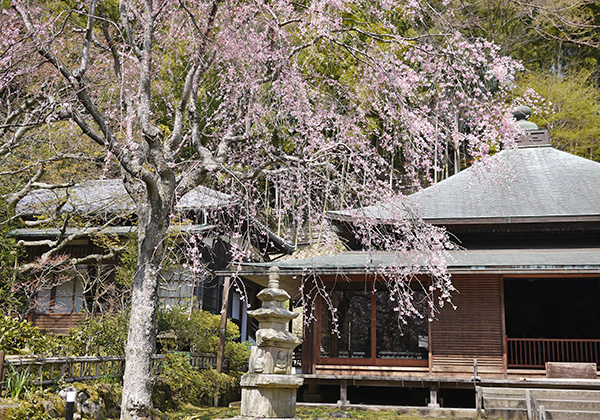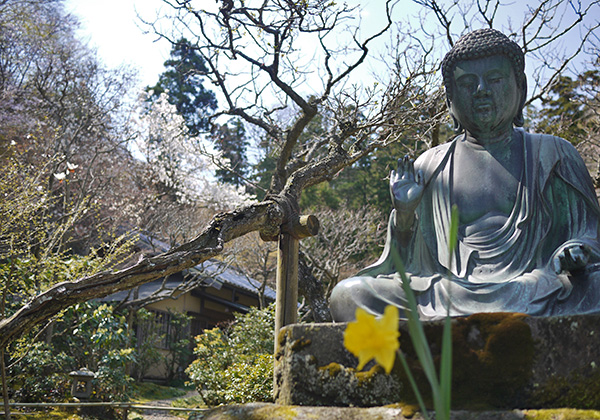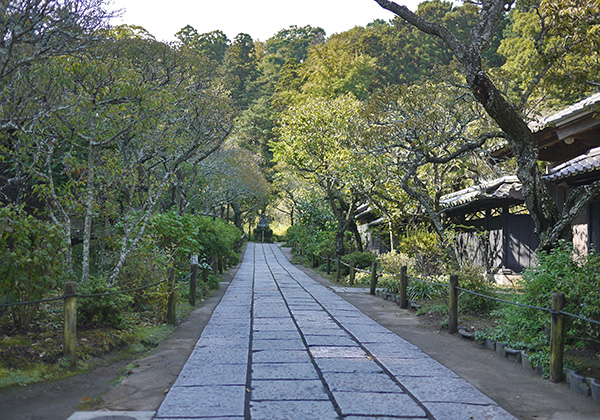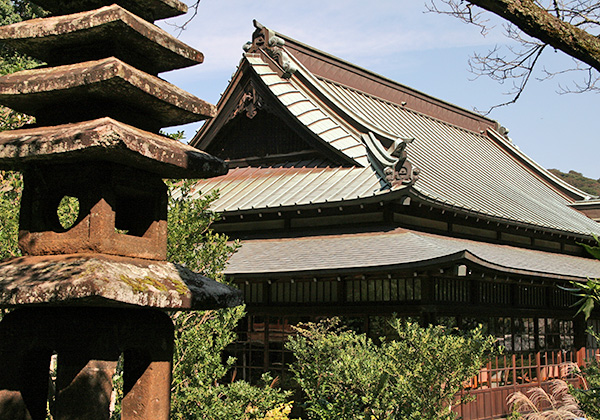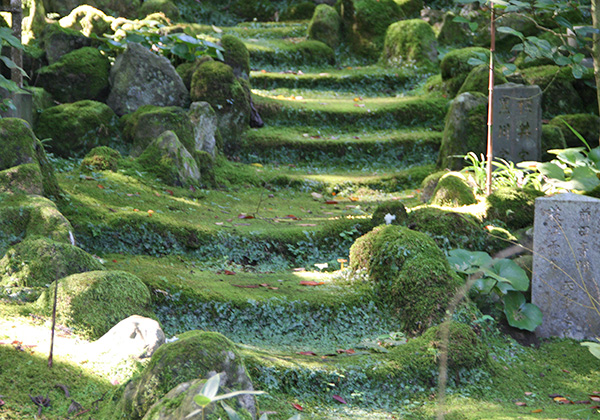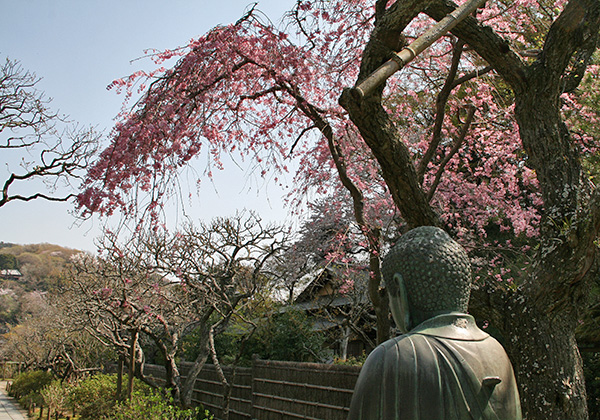Tokeiji
| Official Name | Shokozan Tokei Soji Zenji {Pronounced sho-koh-zan toh-kay soh-gee zen-gee} |
|---|---|
| Religious sect | Engakuji School, Zen (Rinzai) Sect, Buddhism |
| Founded | in 1285 by Sadatoki Hojo {sah-dah-toe-key hoh-joe} |
| Founding priest | Kakusan-ni {kah-koo-san-nee} |
| Main object of worship | Statue of Shaka Nyorai {sha-kah nyo-rye} (Sakyamuni in Sanskrit) |
| Address | 1367 Yamanouchi, Kamakura, Kanagawa 247-0062 (show route from current location ) |
| Location | 250 meters south of Kita-Kamakura Station |
| Time needed to get there | 5 minutes |
| Admission | Free (open yard) |
| Open | 9:00 - 16:00 |
| Phone number | 0467-22-1663 |
| Restrooms | Available at the Treasure House |
Historical Overview
Kakusan-ni (1252-1306) (ni means a nun), the founding nun, was the wife of Tokimune Hojo {toh-key-moo-neh ho-joe} (1251-1284), the Eighth Hojo Regent, who died young at the age of 34. The couple gave birth to Sadatoki Hojo (1271-1311), the Ninth Hojo Regent. She came of a distinguished family by the name of Adachi {ah-dah-chee}, but the Adachis were later involved in the bloodbath power struggle with the Hojos.
In 1285, a year after she lost her husband, a battle broke out between the Hojos and the Adachis, and the Adachis were defeated. Being the head of the Adachis, her elder brother was killed during the battle. She was the mother of the winner on one hand, but was the sister of the loser on the other.
Back then, wives of upper-class families usually became nuns after their husbands died. With her family fortune and her son's social status as the Regent, she founded this Tokeiji as a convent to pray for the repose of the departed husband, and entered nunhood herself. She also made the Convent serve as a refuge for the oppressed women who were unhappy with their husbands. The first women-lib advocate Japan ever produced. Undergoing ups and downs, Tokeiji remained a convent for over 600 years until 1902 when a male priest finally took over the seat of the chief.
Rulers' daughters and even an emperor's daughter were enrolled in the Convent and assumed chief nuns' position making it quite authoritative. The fifth chief-nun Yodo-ni {yoh-doh-nee} (?-1396), for example, was a daughter of Emperor Godaigo {goh-dye-go} (1288-1339) and an elder sister of Prince Morinaga {moh-re-nah-gah} (1308-1335), who was immolated during the battle between the imperial court and the military ruler, and enshrined at Kamakuragu Shrine. She took Buddhist vows to console her brother's soul and came here from Kyoto to hold religious services for her ill-fated brother. As a result, the Convent was sometimes called "Kamakura Palace" or "Matsuga-oka {mah-tsu-gah-o-kah} palace" as the site was so named. Five centuries later in 1869 when Emperor Meiji (1852-1912) wanted to erect the Kamakuragu Shrine for Prince Morinaga, Tokeiji donated part of the land it owned at Nikaido {nee-kye-doh}, where Prince Morinaga was imprisoned and today's Kamakuragu Shrine stands.
The 20th chief nun Tenshu-ni {ten-shoe-nee} (1609-1645) was a granddaughter of Hideyoshi Toyotomi {he-deh-yoh-she toh-yo-toh-me} (1536-1598) who unified Japan in 1590 and became the most powerful ruler in Japan's history. After Hideyoshi's death, Ieyasu Tokugawa {e-eh-yah-soo toh-koo-gah-wah} (1542-1616) took over the ruler's position and his family continued to govern Japan for about 270 years from then on. In the meantime, Ieyasu's grand-daughter Sen (1597-1666) had married Hideyoshi's son Hideyori {he-deh-yoh-re} (1593-1615). Hideyori had two children by a common law wife, one boy and one daughter. When Hideyori was defeated by Ieyasu in 1615 and Ieyasu assumed the ruler of Japan, not only did Ieyasu order Hideyori to kill himself (hara-kiri) at age 23, he also decapitated his 8-year-old son in fear that he might revenge in the future if kept alive. However, Ieyasu saved the life of Hideyori's 7-year-old daughter and sent her to the Convent since Sen was her foster mother. The Convent accepted her cordially getting patronage from the Tokugawa Shogunate and she was eventually nominated as the 20th chief nun by the name of Tenshu-ni. The Convent was so prestigious those days that its couriers did not need to salute with prostration even if they met with feudal lords' procession.
During the time that Tenshu-ni was the chief nun, there was an incident that demonstrated how authoritative the Convent was. It was in early Edo Period (1603-1868) in 1639. Present-day Fukushima Prefecture was then under the control of powerful Kato {kah-toh} feudal lord. The second-generation lord was rather tyrannical and one of his retainer named Hori {hoh-re} was not happy with him. One day, he left the castle together with his 300 or so followers, accusing and criticizing Kato of his despotic behavior. Hori and his men went down to Mt. Koya in Wakayama Prefecture while ordering his wife to run into Tokeiji with their children. Enraged by the betrayal, Kato resolved to apprehend Hori and his family in whatever steps were possible and execute them as soon as they were caught. The Tokugawa Shogunate supported his claim in view of the necessity to maintain and secure the Shogun's authority as well as lord-retainer nexus. Two years later in 1641, he succeeded in catching Hori and executed him as declared in such a cruel manner as dismembering Hori inch by inch, the cruelest manner imaginable, but he failed to retrieve Hori's wife and children who were sheltered in Tokeiji. When Kato's retainers came to Tokeiji and asked to surrender Hori's family, Tenshu-ni flatly declined, saying if they take away the family by force, then she would commit suicide. Kato's men gave up and left the Convent empty-handed. The incident was novelized at least by three authors.
Most famous in the Convent was its function as the Japan's (some insist world's) first refuge for women who suffered abuse by their husbands. In the Kamakura Period (1185-1333) and for centuries thereafter, it was an easy job for a married man to get rid of an unwanted wife. If only he writes a short, divorce letter referred to as Mikudarihan {me-koo-dah-re-han} or "three-and-a-half-lines notice" to her, he was able to divorce without any excusable reasons at all. The letter was a formed one and read like this:"I will divorce you for my personal reasons. You can go anywhere you want and remarry anyone you want". Simply because a married woman was unable to bear a child or whatever, she was often forced to accept an unreasonable divorce.
For affordable men, having concubines was quite natural. One of the Minamoto family had as many as 40-odd children and one of the Shogun of the Tokugawa family in the Edo Period was famous for having over 60 children in his lifetime. By stark contrast, women had no right whatsoever to obtain a divorce from their unwanted husbands, however cruel, drunken, or sadistic they were. It was the society where predominance of men over women prevailed. The only chance for women to escape was to run off to the Convent. In other words, Tokeiji was a sanctuary for the abused wives. Once inside the Convent, they were protected officially by the authorization of the Shogunate. After staying three years (later, two years) in the Convent, their marriage was annulled and they were able officially to get a divorce. Men were denied access. The extraterritoriality. Those women, once accepted by the Convent, did not need to become nuns. In this context, Tokeiji played a pivotal role in freeing many harassed wives from their disgusting husbands.
The Convent was thus named "Kakekomi-dera",{kah-keh-ko-me-deh-rah} or "Run-into Convent", meaning to escape from the violent husbands. It was also referred to as "Enkiri-dera" {en-key-re} or divorce Convent. Unfortunately, the Convent lost many of the ancient documents due to repeated fires, and it is not certain how many women were accommodated here. However, during the latter half of the 270-year Tokugawa Shogunate regime until 1968 in which period most often run-ins were observed, the Convent's records show there were roughly 2,000 women who sought refuge in the Convent. In most cases, however, they did not stay as long as two or three years since the Convent forced their husbands to accept a divorce by its power. It was like today's family court.
The Convent suspended the divorce-setting function in 1873, however, as a new law for divorce was enacted and the Court of Justice started to handle the case. And with the Meiji Restoration earlier in 1868, the Convent had lost financial supporters and waned to the point where only a nun, her maid and a cat lived. Tokeiji thus ceased to be a convent in 1902 when it was placed under the supervision of Engakuji and a male priest, then the chief priest of Engakuji, assumed the post of Tokeiji's supervisor.
In 1893, the second chief priest So-en Shaku {soh-en shah-koo} (1859-1920) visited Chicago to attend the world convention for religion, and made a speech on Zen Buddhism. His speech was translated into English by Daisetz T. Suzuki {dye-seh-tsu soo-zoo-key} (1870-1966), a famous Zen Buddhist scholar, who pioneered in and was credited with introducing Rinzai sect Zen to the West. This is the reason why the Rinzai sect Zen is more widely known overseas than the Soto sect.
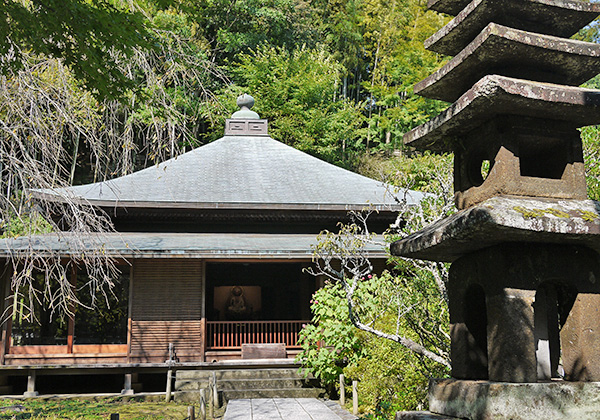
Taiheiden {tie-hay-den} or the Main Hall
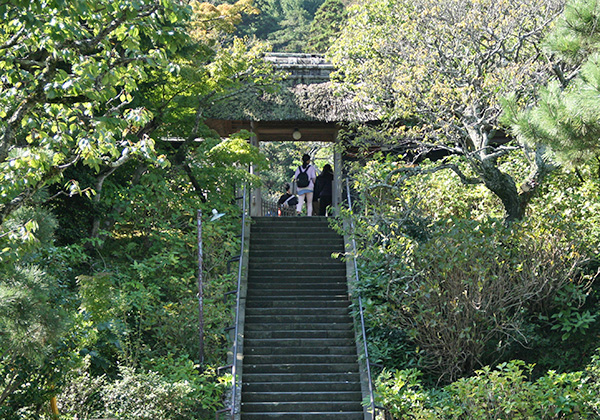
The immediate building appearing to your right after entering the gate is living quarters for priests and the next building with copper-rust roofs is the main hall called Taiheiden, in which a sedentary statue of Shaka Nyorai is enshrined as the main object of worship. The Temple's record shows that the statue escaped a fire in 1515, whereby it is believed to have been fashioned sometime in the Muromachi Period (1336-1573). Sculptors unknown. The building is characteristic of the Zen style architecture with its roofs curved upward and four ridges spread radially. On top of the roof, it has a peach-shaped Buddhist fitting called Hoju {hoe- jew} or mani in Skt. This architectural style is called Hogyo Zukuri {hoh-gyo zoo-koo-re} in Japanese.
Enthroned on the left- and right-hand altars are statues of prominent nuns: the 20th chief nun Tenshu-ni on the left and Kakusan-ni, the founding nun, Yodo-ni, the fifth chief nun on the right. When the Great Kanto Earthquake hit the Kanto area in 1923, many old structures and statues in Kamakura were damaged and those in Tokeiji were not exceptional. Among them was the statue of Tenshu-ni. Except for the head part, it was ruined to a non-recoverable extent. Worse still, there was no photograph, no painting whatsoever to show how it looked like. The Temple sought any possible measures to repair and restore it. They finally found that an English book entitled "Kamakura: Fact & Legend" written by Iso Mutsu {e-so moo-tsu} (1867-1930) and published in 1918 carried a photograph of the statue. Based on this precious photo, Tokeiji restored the statue of Tenshu-ni in 1993 in commemoration of the 70th anniversary of the Earthquake. Iso Mutsu was an English lady who married a Japanese diplomat and lived in Kamakura for a long time. Her book is a classic guide for Kamakura. She died in 1930 and was buried at Jufukuji together with her family.
